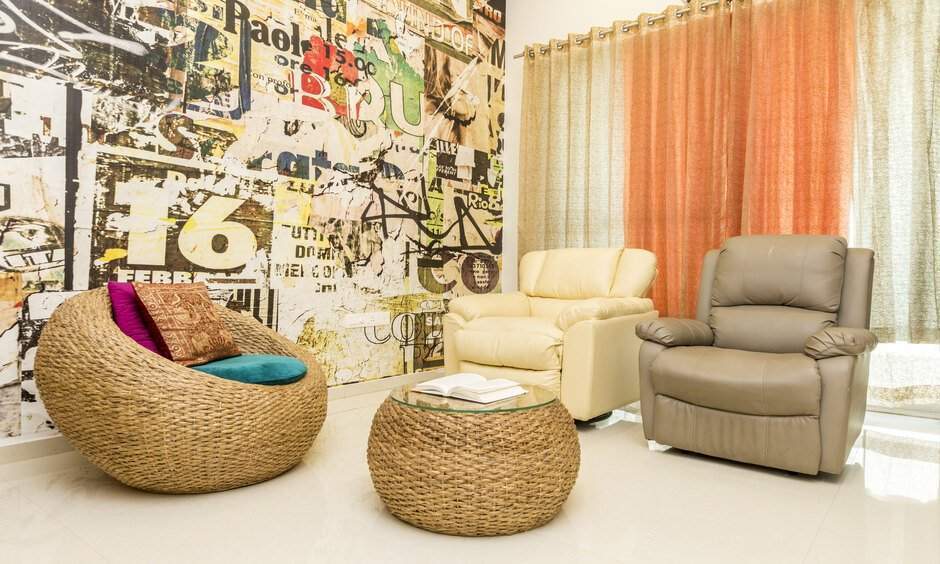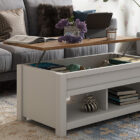Interior design concepts help to plan a perfectly aesthetic and functional home. Let’s explore 5 important interior design concepts in the blog.
Interior designers examine the layout of your home to determine the ideal furniture, lighting, decor and material for the specified rooms while also considering your needs and lifestyle preferences to create a cohesive design.
Interior design concepts are influenced by the architectural style of the space and vice versa. The architecture encompasses structural integrity and functionality, while interior design includes aesthetic design and functionality of the home interior space. Since architecture determines the form, orientation and size of the room, the location of doors/windows and the flow of natural light, and so interior designing aspects should align with it.
For example, if a room has large windows and doors which allow ample natural light, then interior design suggests choosing reflective materials and light colours to create an airy and bright environment.
The 5 Important Interior Design Concepts
There are five crucial elements to any great interior design
- Balance
- Proportion
- Harmony
- Emphasis
- Rhythm
These can be achieved by incorporating:
- Visual Texture (smooth texture = formal feeling, rough texture = casual feeling, complementary textures = drama)
- Form (curved lines = ovals/circles, diagonal lines = triangles, vertical lines/horizontal lines = squares/rectangles)
- Lines (diagonal lines, horizontal lines, vertical lines, curved lines)
- Colour (warmer colours = visually smaller room, cooler colours = visually larger room)
- Space
Read more about the elements and principles of interior design.
Let’s dive into the five most essential concepts of interior design.
Rhythm: Futuristic Interior Design Concept
The futuristic interior design concept is a modern form of interior design that suggests urgency and motion. It is highly experimental in nature, and its key features are:
- Touch-controlled and smart lights, blinds, cabinet and room doors (~smart home technology).
- Long and curved dynamic lines and geometric shapes that balance minimalism and creativity.
- Large furniture that is both experimental, stylish and ergonomic in nature.
- Metallic, leather, glass architectural and abstract decor features.
- Preferable colours are yellow, red, mystic blue and lime.
- Plain and semi-transparent walls with polished finishes.
There is an unspoken rhythm reverberating throughout the room. The space looks cohesive and well-designed, with all the important elements coordinating and supporting each other.

Scale: Open Concept Interior Design
The open concept of interior design is currently trending among homeowners as it features rooms/areas not bound by walls/architectural barriers but more open so that environments can easily blend into each other. The key elements are:
- It allows you to share more moments during daily activities with family and social meetings with friends.
- It encourages solutions that give you the freedom of movement, like moving things around as per the occasion.
- It is more multifunctional and flexible (open spaces can open and close on a need-basis to balance privacy).
- It favours natural light and ventilation through wider doors and windows.

Harmony: Pop Art Interior Design Concept
It is a unique interior design concept which dates back to the 1950s-60s of the 20th century. It is interesting for young people and creative individuals who can go beyond societal stereotypes and patterns. This interior design concept allows you to express individualistic preferences while keeping the harmony of the space intact. Pop art interior design concept is characterised by:
- Incorporation of the principle of minimalism through pull-out beds and built-in wardrobes.
- Boldness and individualism are reflected through striking wall art, decor and household items.
- Fabrics with a glossy finish, such as synthetic or silk.
- Lighting options like bright lamps, disco balls, LEDs and neon lights.
- Bright, acidic, saturated and contrasting colours paired with white colour.

Balance: Colour-Based Concept of Interior Design
The colour-based concept of interior design is rooted in colour theory and colour psychology. Understanding the colour wheel within the interior design context helps you choose the right colours for your space to create a balanced home.
Colours also play a significant role in human psychology and emotions to a large extent since they influence the moods of the people and the ambience of your home. Follow ’60-30-10′ as a thumb rule to maintain a balance where 60 forms the dominant colour of the walls, 30 forms the secondary colour for the upholstery and 10 forms the accent colour for the accessories. Here is a broad overview of the colour-based interior design concept:
- Colour Wheel
- Primary colours (foundation colours) – blue, yellow, red, etc.
- Secondary colours – green, orange, purple, and so on.
- Tertiary colours – blue-green, yellow-orange, red-purple and so on.
- Colour Temperature
- Cool colours (Greens, Blues, Greys, White) – calmness, purity, abundance, solidity, tranquillity, simplicity, reduces anxiety, lowers blood pressure, increases productivity, and makes a space look visually larger.
- Warm colours (Yellows, Browns, Reds) – passion, love, happiness, energy, intimacy, intensity, warmth, inviting, cosiness.
- Colour Schemes
- Triadic colour scheme (using a triadic from the colours that are spaced equally on the colour wheel)
- Analogous colour scheme (using colours that are adjacent on the colour wheel)
- Complementary colour scheme (using colours that are on the opposite sides of the colour wheel)
- Monochromatic colour scheme (using a variety of tones of the same colour/hues)
- Achromatic colour scheme (true neutrals without any colour like greys, white and black)
- Tetradic colour scheme (using variants of dual colours that are evenly distributed across the colour wheel)
- Split complementary colour scheme (using two colours on the opposite ends of the colour wheel, with one of them being split into two more adjacent colours).
- Colour Dimensions
- Intensity (relative degree of strength and purity)
- Value (relative degree of lightness and darkness)
- Hue (name of the pure colour without shade or tint)
- Tints (lighter colour tones than the regular ones of pure hues in the colour wheel)
- Shades (darker colour values than the normal ones of pure hues in the colour wheel)
- Contrasts (smaller variations = lower contrast, larger variations = higher contrast)

Proportion: Transitional Interior Design Concept
The transitional interior design concept combines traditional design with modern style to create a ‘fluid’ look that allows for change and growth. In other words, a transitional interior design is rooted in a traditional aesthetic, but the silhouettes are more updated and less fussy while keeping a strict eye on proportions to not overwhelm a space. The key features are:
- Overall muted colour scheme with pops of colours through pillows, artwork and rugs.
- Comfortable/practical furniture which combines straight/curved lines.
- Organic textures with a special focus on ‘layering’.
- Statement lighting options and metallic accents.
- Large-scale patterned textiles which don’t overwhelm a space

It is essential to be aware of the most important interior design concepts to easily design the home of your dreams. Contact the interior designers’ team at DesignCafe, and they’ll give you more insights into the vast world of interior design. Good Luck!
FAQs On Interior Design Concepts
Can nature inspire an interior design concept?
Of course, it can. Most urban homeowners are inclined towards nature and try to incorporate natural elements into their home interiors to promote tranquillity and peace, which is very much missing in the hustle and bustle of city life. This affinity of human beings with the natural world is called ‘biophilia’. There are many ways in which you can merge the indoors with the outdoors (nature):
- Decor – flowers, living walls, green potted plants, kitchen herb gardens
- Colours – white, green, grey, beige, blue, yellow, pink
- Textiles – vegetable fibres, faux fur, hemp, linen
- Furniture – natural stone, wood, clay, wicker
- Shapes – curvaceous (~avoid straight lines), organic (~free flowing)
- Embrace airflow, natural light and minimalism wherever possible
How do you know if your interior design concept suits your lifestyle?
Answer a few questions to cross-check and reaffirm if your interior design concept suits your lifestyle:
- Do guests find it comfortable to walk around/start up conversations in different corners freely?
- What are your colour preferences – vibrant colours or toned-down colours?
- Do you have a traditional bent of mind or a more modern outlook?
- Do you believe in religious practices, ancient traditions and cultural norms?
- Do you have elderly people or little children staying with you?
- Do you live a nuclear lifestyle or in a joint family system?
- Do you have pets at your home?
- Do you live in a small home or a large home?
Is it possible to mix different interior design concepts/styles in one space?
If you have a large space and are pretty open on the budget, you needn’t restrict yourself to one interior design style. You can mix more than one (max. three) interior design styles in a unified scheme to set new and unique trends. For example, fuse a rustic interior design aesthetic with elegant minimalist features to create a visually attractive and functionally-effective space while maintaining its authenticity.
You can use some tips to achieve the fusion of interior design styles:
- Take a sneak peek into your desired environment/aura you want to create and determine which elements can fit the game and which ones cannot fit the game based on ‘sensations’.
- Use an ’80/20′ ratio, i.e. 80% of a room should reflect one style and 20% should be pulled from the contrasting style. Art can also be smartly incorporated to combine both styles.
- Become a ‘master’ of the colour scheme and focus on textures/patterns to create a ‘linkage’ between the designs. For example, use traditional wooden furniture with modern wall panels featuring similar motifs/hues.
- Draw attention to an assorted decor collection/piece of furniture (~that doesn’t look like the rest of the stuff) as a ‘focal point/wow factor’ and build the rest of the room around it.
- Keep the items similarly sized and on the same scale, or group smaller items together to create an interesting display.
Based on these questions, you can implement house interior design tips accordingly.
 Select Category
Select Category 












